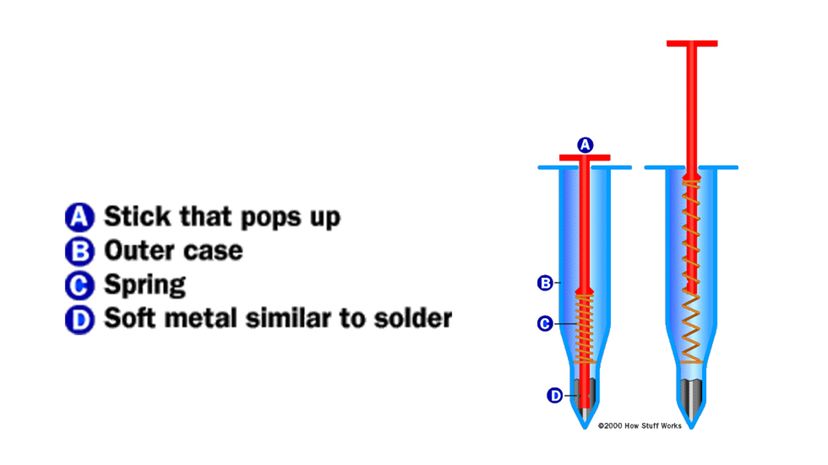If theres one thing ubiquitous with the American holiday of Thanksgiving, its eating turkey. Millions of people throughout the United States sit down to a big meal that typically includes turkey as one of the main courses. Dining on a big roasted or fried bird has been a staple for centuries because turkey is one of the foods believed to have been shared between the pilgrims and Native Americans when they celebrated the first Thanksgiving in 1621. (Although we now know that its more likely they may have eaten fowl like ducks and geese along with some venison, explains NPR.)
For many people, roasting a turkey is a little bit easier thanks to a simple little gadget known as the pop-up timer. This smart piece of technology lets you know when your turkey is done so you dont have to stress over it. All you have to do is wait until the red indicator stick pops up and you know the bird is done and its time to eat.
But have you ever wondered how that timer knows exactly when your turkey is completely cooked? Read on to find out.
As Thanksgiving approaches, many home cooks are preparing to roast a turkey for the first time. And when they open the packaging, they’re often surprised to find a mysterious plastic object attached to the bird. What exactly is this thing, and what should you do about it before popping your turkey in the oven? I’ll explain what the plastic insert is for, whether it needs to be taken out, and how to remove it properly.
It’s Usually a Pop-Up Timer
The most common plastic piece found on store-bought raw turkeys is called a pop-up timer It’s a small plastic device inserted into the breast meat that pops up when the turkey reaches the ideal minimum internal temperature of 165°F
The pop-up timer contains a coil spring inside a heat-sensitive plastic capsule. Once the turkey breast hits 165°F the plastic melts away releasing the spring and causing a small button to pop up quickly. This signals doneness to the cook.
Pop-up timers provide a helpful doneness guideline, but they aren’t extremely precise. Using an instant-read meat thermometer is more reliable for ensuring the turkey is fully and evenly cooked.
Sometimes It’s a Plastic Hock Lock
While less common than pop-up timers, some turkeys have thick plastic bands called hock locks wrapped around the legs. A hock lock simply keeps the drumsticks contained neatly against the body for packaging.
Hock locks are made from food-safe, high-heat plastic and are not intended to be used while roasting. They don’t serve any purpose for cooking the bird properly.
Should You Remove It Before Cooking?
Poultry experts generally recommend removing pop-up timers and hock locks before roasting your turkey. Here are three key reasons why:
-
Removing it allows for even cooking and browning. Leaving a plastic insert on can interfere with airflow and shield areas like the thighs from roasting as quickly. Taking it off enables uniform roasting.
-
Seasonings reach more surface area. With legs locked together, seasoning the thighs is obstructed. Removing any bindings provides full seasoning access.
-
Access the cavity easily. A hock lock makes reaching into the cavity to take out the giblets difficult. Removing it provides easier access.
Overall, letting your turkey roast completely free of plastic bindings gives the best results.
How to Remove the Plastic Pieces
Removing pop-up timers and hock locks is simple:
For a pop-up timer: Use clean hands or utensils to grasp the button and wiggle it gently from side to side. It should detach easily from the breast meat, leaving just a small hole behind.
For a hock lock: Use clean kitchen shears or sturdy scissors to simply clip the plastic band in one or two spots. It will then slide right off the legs with no trouble. You can also just cut the band off completely.
Once removed, be sure to double check that the giblets and neck were taken out of the turkey cavity. Then you’re all set to rub it down with spices and herbs!
Trust Your Thermometer for Guaranteed Safety
While pop-up timers can provide a ballpark estimate for when the turkey is done, they don’t guarantee 100% safety and proper doneness. Using an instant-read digital meat thermometer is far more reliable.
Check the temperature of the thickest part of the breast and thighs, ensuring they both reach 165°F. Let the turkey rest before carving for juicy, tender meat the whole family will love.
Removing any plastic trussing or timers leads to ideal even roasting. But always depend on your thermometer, not the pop-up alone, for perfection.
With the mysterious plastic pieces decoded and discarded, you can now roast your turkey with confidence. Stay tuned for more tips to nail Thanksgiving dinner!

A Funky Thermometer
If your turkey has a pre-inserted pop-up timer — most turkeys you buy from the grocery store do — you dont have to worry about using a separate meat thermometer. When the turkeys timer pops up, its signaling to you the bird is done. Heres how it works:
A pop-up timer found in a turkey or chicken normally has four parts (see above):
- A: The stick that pops up (typically red)
- B: The outer case (typically white or light blue)
- C: A spring
- D: Piece of soft metal similar to solder
The soft metal (D in the ) is solid at room temperature but turns to a liquid (melts) at about 165 degrees Fahrenheit (73 degrees Celsius). When the metal melts, it releases the red stick (A) and the spring (C) pops up the stick so you know the turkey is done.
Turkey is done when it reaches 165 degrees Fahrenheit (73 degrees Celsius). If your turkey didnt include a pop-up timer, you can use a meat thermometer to check the internal temperature for doneness. Simply insert the thermometer into the innermost part of the turkeys thigh and wing, and the thickest part of the breast, being sure not to hit bone. If it registers 165 degrees Fahrenheit, its done.
One little-known fact is that these timers are reusable. If you dip the tip in hot water it will re-melt the metal and you can push the pop-up piece back into place. Then let it cool, and the pop-up piece will be back in its original position — ready to use again.
Removing Plastic Clip
FAQ
Should I take my turkey out of the wrapper?
Important Tip #1: Take the turkey out of the packaging in the cooking pan. There is two layers of plastic wrap on the bird and if you cut into the second layer all of the juices will release so you want to make sure it is safely in the pan to preserve the yumminess and not make a mess.
What is that plastic thing in my turkey?
The turkey I purchased had something that looked like a plastic “button” in the breast. What is it, should I remove it before cooking the turkey? The “button” you referred to is a pop-up temperature indicator, commonly called a Pop-Up Timer. No, the Pop-Up Timer should not be removed before cooking.
Do you cook turkey with a plastic holder?
When cooking a turkey, it is generally recommended to remove the plastic insert before cooking. The plastic insert is often found in the neck or body cavity of the turkey and is used to hold the legs in place during packaging (1). Here are some reasons why it is advised to remove the plastic insert:
Should I remove the plastic Hock lock from my Turkey?
Not to mention that properly cleaning and stuffing your turkey can be difficult when the legs are tied together, which is why for overall use and ease of cooking, we recommend that everyone removes the plastic hock lock from their turkey. We also don’t trust those temperature pop-up temperature indicators, but we will leave that decision to you.
How to remove plastic ties from turkey legs?
At this point, it is a good idea to remove the plastic. How To Remove The Plastic Ties From Turkey Legs You will need to cut the plastic with a pair of sharp kitchen scissors. Once loosened, pull gently to extract it from the skin and meat on the legs without damaging the turkey’s appearance. What If I Want To Stuff My Turkey?
Should you remove plastic inserts before roasting a Turkey?
Most experts recommend removing any plastic inserts before roasting your turkey. Here’s why: Leaving a hock lock or timer attached can interfere with airflow and prevent the thighs from cooking as quickly as the breast. Removing it enables the legs and thighs to roast evenly along with the rest of the turkey.
Can you throw out a turkey if you melt plastic?
Melting plastic can release dangerous chemicals, and as difficult as it may seem to throw out a turkey you’ve worked so hard on, you must do so for the safety of your friends and family, which is why it is essential to check the turkey for the giblets bag in advance.
How do you know if a Turkey has a hock lock?
If you bought your turkey from the grocery store, you will probably open it to find a plastic band around its legs. Generally, this is referred to as the “hock lock” and is used to keep the turkey in form while it is being processed and packaged. Some turkeys will have a second piece of plastic in them, known as a pop-up indicator.
Can you put paper wrapped giblets inside a Turkey?
Here are the answers from the USDA Meat and Poultry Hotline. Leaving the paper- or plastic-wrapped giblets inside the turkey during cooking: Some giblets are paper wrapped before being inserted into the poultry body cavity. In this case, there would be no concern if the giblets are accidentally cooked inside the bird to a safe temperature.

